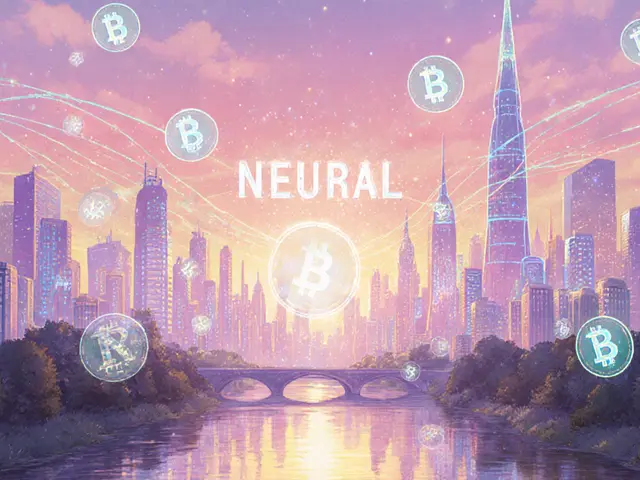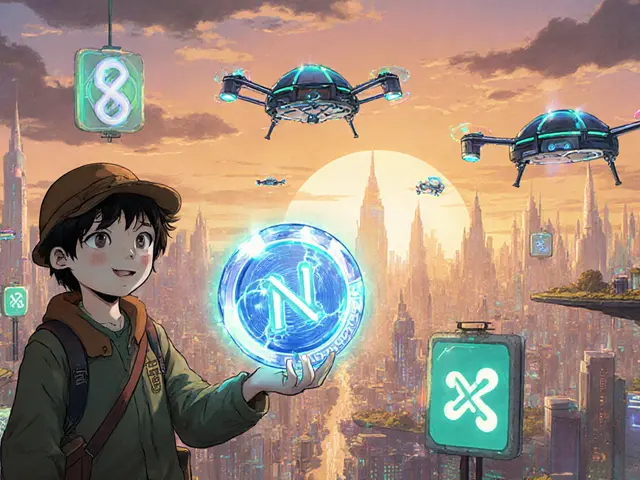16
Underground Crypto Trading in Nepal: Methods, Risks, and Enforcement

Nepal Crypto Trading Risk Calculator
Your Risk Assessment
Legal Risk
Financial Risk
Operational Security
Overall Risk Level
Underground crypto trading in Nepal is a shadow market that thrives despite the total ban on cryptocurrency activities imposed by the Nepal Rastra Bank in 2017. While the government treats digital assets as illegal, many Nepalis still turn to crypto for cross‑border remittances, investment opportunities, and to bypass the formal banking system.
Why the Ban Exists and What It Covers
In 2017 the Nepal Rastra Bank (NRB the central bank of Nepal, responsible for monetary policy and financial regulation) issued a circular that prohibited mining, trading, and even possession of cryptocurrencies such as Bitcoin. The ban is reinforced by the Criminal Code 2074, which classifies unauthorized virtual‑currency activity as a cybercrime punishable by hefty fines and up to five years in prison. Since then the Nepal Telecommunication Authority (NTA the regulator that controls internet and telecom services in Nepal) has blocked crypto‑related websites and monitors IP traffic for signs of illegal access.
How Traders Slip Past the Restrictions
The underground ecosystem relies on a mix of technical work‑arounds and social coordination. Here are the most common tactics:
- P2P platforms: Services like Binance P2P allow users to trade directly with each other. Payments are settled via local methods such as eSewa (eSewa a popular Nepali digital wallet and payment gateway) or traditional bank transfers, making the flow harder for authorities to trace.
- VPN usage: Traders hide their IP addresses with Virtual Private Networks (VPN software that creates an encrypted tunnel to route internet traffic through servers outside Nepal). This lets them reach blocked exchanges and P2P sites.
- Encrypted messaging: Groups coordinate trades on Telegram and WhatsApp, sharing wallet addresses, price quotes, and escrow instructions. Although both apps are widespread, the police have stepped up surveillance of these channels since 2022.
- Multiple banking relationships: To disguise transaction patterns, some traders open accounts at several banks, use “hawala” style informal money transfer networks, or split payments into small amounts below reporting thresholds.
Key Tools and Platforms in the Underground Market
| Tool | Primary Purpose | Typical Access Method | Risk Level |
|---|---|---|---|
| Binance P2P a peer‑to‑peer crypto marketplace run by Binance | Direct buying/selling of Bitcoin, USDT, etc. | Web or mobile app via VPN | Medium - trades are user‑matched but escrow can be compromised. |
| Telegram Groups encrypted chat rooms where traders share signals and escrow services | Coordination and trust building | App on smartphone (often using VPN) | High - law enforcement can infiltrate groups. |
| VPN Services software that masks real IP, e.g., NordVPN, ExpressVPN | Bypass ISP blocks | Desktop or mobile client | Medium - logs may be seized if provider cooperates. |
The Risk Landscape for Underground Traders
Engaging in illegal crypto activity carries several layers of danger:
- Legal consequences: Arrests have resulted in up to five years imprisonment and fines exceeding Rs 10 million. The July 2025 case involving two Indian nationals demonstrated that police can trace even well‑masked operations.
- Financial loss: Without regulated escrow, traders risk scams, double‑spending attacks, or loss of private keys.
- Surveillance exposure: The Central Investigation Bureau (CIB the elite investigative unit of Nepal Police focusing on organized crime and cyber offenses) monitors bank transaction patterns, IP logs, and even encrypted chat metadata.
- Psychological stress: Constant fear of raids forces traders to work at odd hours, use multiple devices, and live with the anxiety of potential raids.

Recent Enforcement Highlights
Authorities have intensified crackdowns in the past three years. Notable actions include:
- 2022: Raids on two illegal exchange kiosks in Kathmandu, resulting in five arrests and seizure of crypto wallets.
- 2024: NTA blocked over 1,200 crypto‑related domains; VPN traffic spiked as traders adapted.
- July 2025: The CIB busted a clandestine operation at a grocery store in Lalitpur, confiscating Rs 820,000 in cash and seizing CCTV footage that linked the owners to Rs 1.5billion worth of crypto trades.
These actions illustrate that the government targets both large‑scale operators and individual traders.
What It Takes to Operate Underground
Successful participants develop a skill set that blends finance and cybersecurity:
- Understanding of basic cryptocurrency concepts - wallets, public/private keys, transaction fees.
- Proficiency with VPN configuration and choosing servers outside the Indian subcontinent to avoid regional monitoring.
- Ability to navigate P2P platforms, set up escrow contracts, and verify counterparties.
- Knowledge of Nepal’s banking AML thresholds to split payments effectively.
- Operational security (OPSEC) habits: using burner phones, regularly clearing chat histories, and employing multi‑factor authentication.
Most newcomers rely on experienced community members for tutorials, often shared as PDFs or voice notes on encrypted channels.
Future Outlook: Will the Ban Ever Loosen?
Global crypto adoption continues to rise, and neighboring countries like India and Bhutan are moving toward regulated frameworks. Yet Nepal’s stance remains unchanged as of 2025. Analysts point to three possible scenarios:
- Status quo: The government keeps the ban, and underground trading continues to evolve with newer tools (e.g., decentralized finance bridges).
- Partial liberalization: Under pressure from the diaspora and remittance needs, Nepal may allow limited crypto services for cross‑border transfers while keeping retail trading illegal.
- Full legalization: Unlikely in the short term, but a shift could happen if regional agreements standardize AML/KYC protocols.
For now, the market operates in the shadows, and anyone considering participation should weigh the legal exposure against potential profit.
Quick Takeaways
- Crypto is fully banned in Nepal; violations can lead to prison.
- Underground traders use VPNs, P2P platforms, and encrypted messaging to stay active.
- Law enforcement has successfully targeted both small operators and large cross‑border schemes.
- Technical knowledge and strict OPSEC are essential to survive in this high‑risk space.
- The future may bring regulatory change, but underground activity is likely to persist while demand remains.
Frequently Asked Questions
Is it legal to own Bitcoin in Nepal?
No. The Nepal Rastra Bank’s 2017 circular explicitly prohibits owning, buying, selling, or using Bitcoin and any other digital currency. Penalties include fines and up to five years imprisonment.
How do people circumvent the ban?
Most traders rely on VPNs to hide their IP address, access P2P marketplaces like Binance P2P, and settle payments through local wallets such as eSewa or via informal hawala networks. Encrypted chat apps help coordinate trades.
What are the biggest risks?
Legal prosecution, financial loss from scams, and constant surveillance by the Central Investigation Bureau. Even with VPNs, authorities can trace banking patterns or infiltrate chat groups.
Has anyone been arrested recently?
Yes. In July 2025, two Indian nationals were arrested in Lalitpur for running a crypto operation worth over Rs 1.5billion. Police seized cash, devices, and CCTV footage linking them to the illegal trades.
Will Nepal ever legalize crypto?
There is no official plan for legalization yet. Analysts see three possible paths: continue the ban, adopt a limited framework for remittances, or eventually move toward full regulation. Change is unlikely in the immediate future.









Bobby Ferew
February 16, 2025 AT 07:51The current crypto clampdown in Nepal operates like a labyrinthine regulatory matrix, where each VPN tunnel becomes a potential vector for law‑enforcement interception, and every P2P escrow is a high‑risk contract under the shadow of the Criminal Code.
celester Johnson
February 16, 2025 AT 08:51When you dissect the risk calculus, you realize that legal exposure, financial volatility, and operational opacity form a triad that mirrors the classic “three‑body problem” in physics-unstable, unpredictable, and demanding precise mitigation strategies.
Prince Chaudhary
February 16, 2025 AT 09:51For anyone stepping into this underground scene, start by mastering your wallet fundamentals, then lock down your VPN endpoints, and finally practice the “small‑batch” payment method to stay beneath AML thresholds.
John Kinh
February 16, 2025 AT 10:51Honestly, most of these “sophisticated” setups are just glorified cat‑videos of people pretending they’re hackers.
Mark Camden
February 16, 2025 AT 11:51Morality isn’t a market, it’s a legal sentence.
Evie View
February 16, 2025 AT 12:51Engaging in illicit crypto trading isn’t a daring adventure; it’s a reckless gamble that can shatter families, bankrupt individuals, and feed a cycle of corruption that erodes societal trust.
Kate Roberge
February 16, 2025 AT 13:51Everyone loves a good hype train, but the reality is that these “decentralized” platforms are just centralized scapegoats in disguise, feeding the illusion of freedom while the state watches.
Oreoluwa Towoju
February 16, 2025 AT 14:51Remember: sharing knowledge responsibly is the best defense against scams-teach peers how to verify escrow contracts before any transfer.
Jason Brittin
February 16, 2025 AT 15:51Wow, the underground market is basically a glorified coffee shop where people trade beans for secret passwords 😂
Amie Wilensky
February 16, 2025 AT 16:51One might argue that the enforcement apparatus, while seemingly opaque, actually follows a predictable pattern of targeting high‑volume operators; however, the collateral damage inflicted upon low‑level participants often goes unnoticed; this asymmetry underscores a systemic flaw in the policy's design.
MD Razu
February 16, 2025 AT 17:51Risk assessment in Nepal's crypto underworld is not merely a numerical exercise but a narrative of survival; each trader must reconcile personal ambition with the specter of incarceration. The legal framework, anchored by the 2017 NRB circular, creates a binary state where compliance is impossible and defiance is punishable. Operational security hinges on VPN reliability, which, while effective against ISP throttling, can be compromised by jurisdictional data requests. Financial exposure is amplified by the absence of regulated escrow, leaving participants vulnerable to double‑spending schemes. Psychological stress, an often‑overlooked dimension, manifests in constant vigilance and fragmented social interactions. Community trust is built through layered verification, such as multi‑signature wallets and reputational scoring within Telegram groups. The usage of eSewa as a fiat bridge introduces additional AML scrutiny, as transaction limits are monitored for pattern anomalies. Hawala networks, while clandestine, provide a cash‑heavy alternative but lack audit trails, increasing both risk and resilience. Enforcement agencies, especially the CIB, have refined digital forensics, employing packet inspection and cross‑border cooperation to trace illicit flows. Despite these pressures, the demand for cross‑border remittance drives innovation, prompting traders to adopt decentralized finance bridges. Future regulatory shifts could either legitimize modest pathways or further entrench underground mechanisms, depending on political will. In the meantime, education remains the most potent tool; traders who internalize cryptographic fundamentals reduce susceptibility to scams. Diversifying operational habits-such as rotating VPN servers and employing burner phones-mitigates single‑point failures. The broader societal impact includes erosion of trust in formal financial institutions, nudging more citizens toward informal economies. Ultimately, each participant must weigh the potential profit against a matrix of legal, financial, and personal risks, recognizing that the cost of failure can far exceed any short‑term gains.
Charles Banks Jr.
February 16, 2025 AT 18:51People love to hype the “freedom” narrative, but underneath it’s a supply‑and‑demand market that fuels money‑laundering and draws the attention of every cyber‑crime unit in the region.
Ben Dwyer
February 16, 2025 AT 19:51Take it step by step: start with a solid VPN, then verify the escrow process, and finally keep transaction amounts under the reporting threshold to stay safer.
Lindsay Miller
February 16, 2025 AT 20:51I get the humor, but the reality hits hard-those “coffee shop” vibes hide real financial peril for anyone unprepared.
Katrinka Scribner
February 16, 2025 AT 21:51True, the law isn’t a suggestion; it’s a hard line that many cross without caring.